

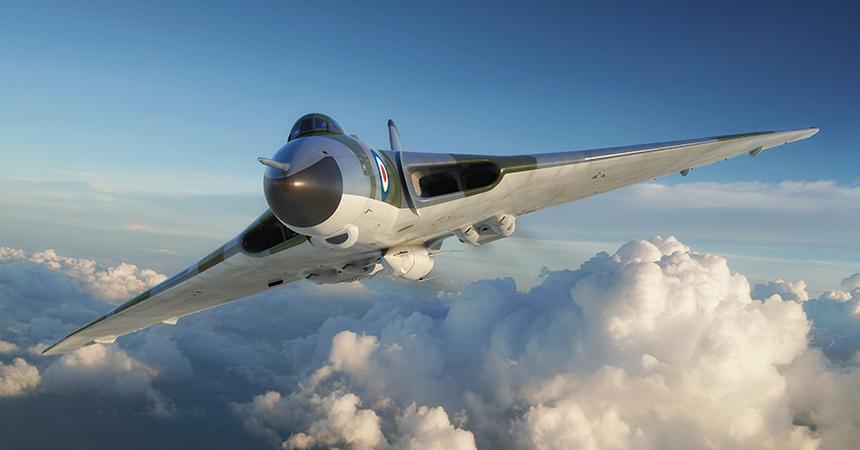
Welcome to this latest edition of Aerodrome and our regular look at the fascinating world of aeroplanes and the historic aviation scene in the UK.
With both the Tornado and Tucano now retired from Royal Air Force service, we are determined to lift the aviation mood a little in this latest edition of our blog, by paying tribute to an aircraft which can claim to be the ‘First and the last’ of its kind. A relic of the Cold War, this aircraft went on to become arguably the most famous individual aircraft to take its place on the UK Airshow circuit and captivated a nation during a final farewell tour which saw huge crowds turning out for one final glimpse of her in the air. Edition 132 of our blog is a celebration of the much missed Avro Vulcan B.2 XH558 and her enduring aviation legacy.
Last weekend, the Airfix team announced the development of a newly tooled 1/72nd scale model kit of the Vulcan B.2 to great acclaim at the Scale Modelworld Show and with it, underlined the continued interest in an aircraft which was an icon of the Cold War and one of the most distinctive aircraft ever to take to the skies. As if we ever need an excuse to extoll the virtues of the mighty Vulcan, it is also four long years since the last flying example of the aircraft made its final flight at Doncaster Sheffield Airport to the dismay of millions of enthusiasts and into a retirement which many hoped could have been avoided. Nevertheless, it’s time to celebrate this magnificent aircraft, sad that it is now grounded, but thankful we got to experience it in the first place.
Calling all Vulcan fans – we are asking Aerodrome readers to share their photographic memories of Avro Vulcan B.2 XH558 with fellow readers, by sending us a small selection of your images to our usual aerodrome@airfix.com contact address. These pictures will form a large section of the review edition of our blog, which is posted between Christmas and the New Year and will allow contributing readers to start 2020 by playing a starring role in the blog. Please don’t be shy, it’s time for some Vulcan indulgence!
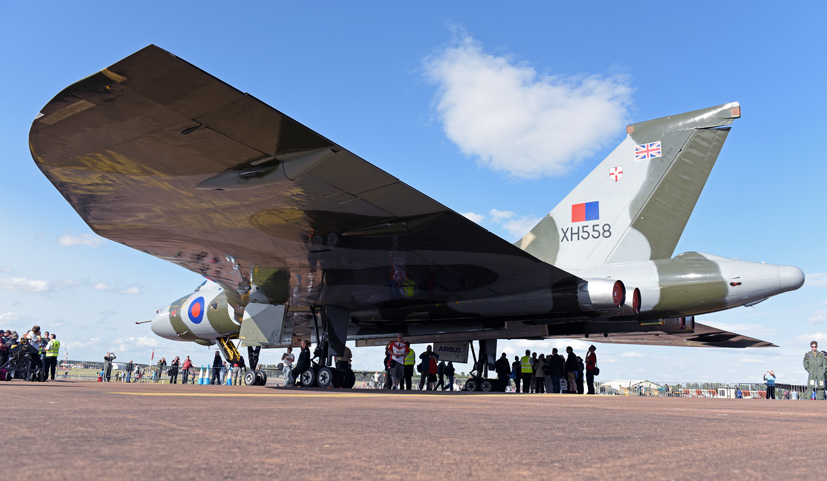
The Vulcan could always be assured of attracting a sizeable crowd wherever she turned up
The years which followed the end of the Second World War saw the rapid development of jet powered aviation and the acceptance that nuclear technology had changed the world forever. With tensions between former wartime allies forcing them to settle on either side of an ideological Iron Curtain, the Royal Air Force were looking for a capable new jet powered bomber, which incorporated all the latest technology and possessed the ability to strike deep into the Eastern Bloc. With challenging Ministry of Defence requirements posting specifications which represented a 100% increase against the capabilities of any bomber which had gone before it, the design engineers at Avro set about producing one of the world’s truly great aeroplanes and one which would provide Britain with a powerful deterrent against future conflict.
Having produced previous multi-engined aviation classics such as the Manchester, Lancaster and Shackleton, the Avro design team were well placed to continue this heritage with their new bomber project, however, the demanding specifications would force them to explore new concepts and push the very boundaries of aerodynamic technology. As the huge doors of Avro’s Woodford aerodrome construction hangar were pushed back on 30th August 1952 and Avro Vulcan prototype VX770 was wheeled out onto the hardstanding outside, she must have made for a breathtaking sight. Resplendent in its white ‘Anti-Flash’ paint finish and proudly wearing Royal Air Force insignia, what the Avro engineers had managed to produce was not only the world’s first delta bomber, but also the most advanced bomber in the world.
As Avro’s chief test pilot Roland ‘Roly’ Falk took off from Woodford’s runway in Vulcan prototype VX770 and embarked on the aircraft’s maiden flight, he quite literally brought the county of Lancashire to a standstill, as anyone in the vicinity of its flightpath stopped to marvel at the unusual sight of this distinctive bomber in the sky. Unwittingly, they became the first people to experience the aviation phenomenon which would later be described as the ‘Vulcan Effect’.
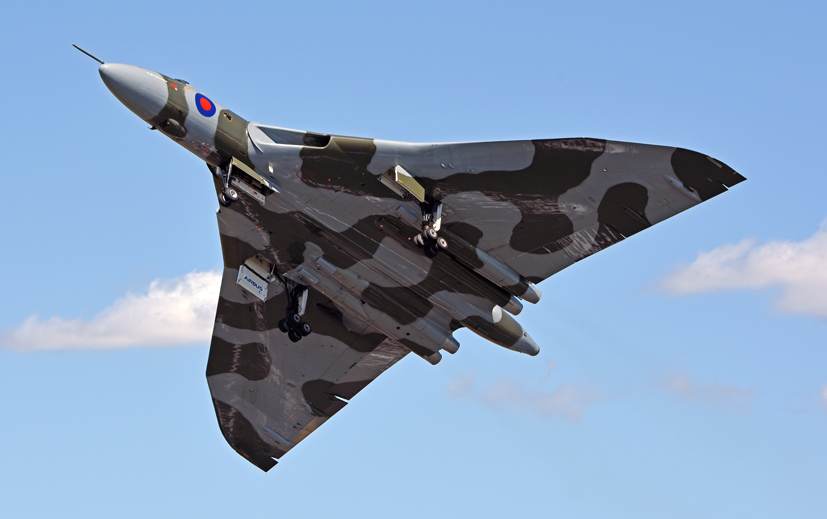
Arguably the most distinctive shape ever to appear in Britain’s skies, it is no wonder so many people became captivated by the ‘Vulcan Effect’
The Avro Vulcan eventually entered Royal Air Force service with No.83 Squadron at Waddington in July 1957 and with it, presented the RAF with one of the most advanced aircraft in the world - the aircraft was at that time not only the world’s first delta bomber, but also the fastest nuclear capable bomber in the world. It seems something of a strange dichotomy to describe an aircraft which possessed such devastating destructive potential as Britain’s most effective peace keeping asset, but that is exactly what the Vulcan was. Throughout the aggressive posturing of the Cold War, Warsaw Pact nations were in no doubt that if they dared to launch an attack against a NATO country, the consequences of the inevitable retaliatory strike would be catastrophic. At that time, nothing seemed to represent this doomsday scenario more effectively than the mighty Avro Vulcan.
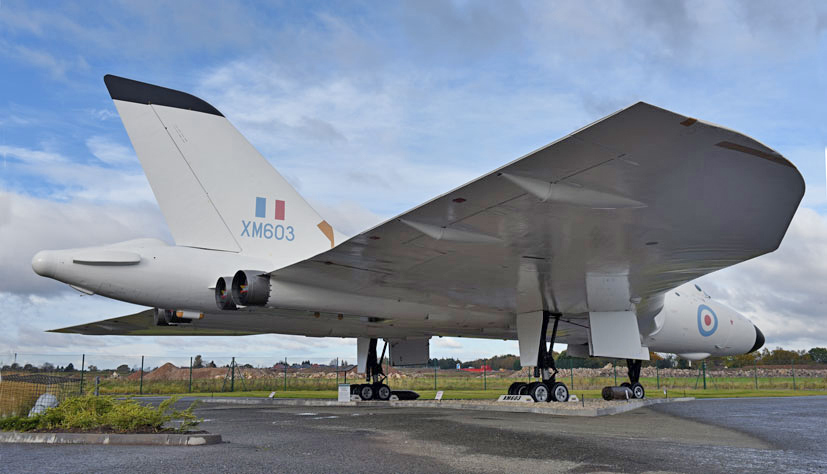
When XH558 made its delivery flight from Woodford to Waddington in July 1960, it was finished in a white anti-flash scheme, similar to the one currently worn by the Avro Heritage Museum’s XM603
When Avro Vulcan XH558 made its first flight from Woodford aerodrome on 21st May 1960, few could have known that this first upgraded B.2 variant of the Vulcan would go on to be arguably one of the most famous individual aircraft in the history of British aviation. Delivered to Waddington on 1st July the same year, she became the RAF’s first Vulcan B.2, initially serving with No.230 Operational Conversion Unit, but later also with Nos.44, 50 and 101 Squadrons of the Waddington Wing.
During an interesting service career, XH558 would become one of only nine Vulcans selected for conversion to SR.2 standard and use by No.27 Squadron in the long-range maritime radar reconnaissance role, also possessing the ability to collect air samples from extremely high altitudes, for scientific analysis.
Although not directly taking part in the Falklands War, the conflict would have an impact on six Vulcan airframes, including XH558, as Victor tanker fatigue issues and the lack of an effective replacement called for drastic action. As a ‘stop-gap’ measure, these Vulcans were converted to K2 standard and given the ability to provide air-to-air refuelling support for RAF aircraft. Modified to include three additional internal fuel tanks and a single hose-drum unit under the rear tail-cone area of the aircraft, these Vulcans proved surprisingly effective in the role, particularly when considering it only took six days from the first flight of the modified prototype airframe to the type’s service introduction – more success for the Avro technicians.
Ultimately, the service days of the RAF Vulcan force were already numbered and aircraft withdrawals (along with their scrapping) started to take place from the end of 1980. Most of the final aircraft in service ended up being the K2 tanker conversions on strength with No.50 Squadron, however, with the disbandment of this unit on 31st March 1984, the operational service career of the Vulcan was over. The final service withdrawal date for XH558 is noted as 17th September 1984, but this would not be the end for this particular Vulcan.
Reflecting the great affection in which the public held the world’s first delta bomber, the Royal Air Force decided to form the Vulcan Display Flight and maintain one aircraft for Airshow demonstration purposes. Due to her low flight hours, XH558 was selected to serve as the display airframe and was therefore returned back to her previous B.2 configuration. Making her first public display appearance in May 1985 and would go on to thrill millions of Airshow enthusiasts over the next few years, with her dynamic displays of fighter like performance belying her status as Britain’s nuclear delta bomber. For the next seven years, she would be the highlight act at many an Airshow as the last flying Vulcan in the world and even encourage a small band of committed enthusiasts to attempt a fund raising campaign to keep the aircraft flying indefinitely, following her around the country, wherever she was scheduled to perform.
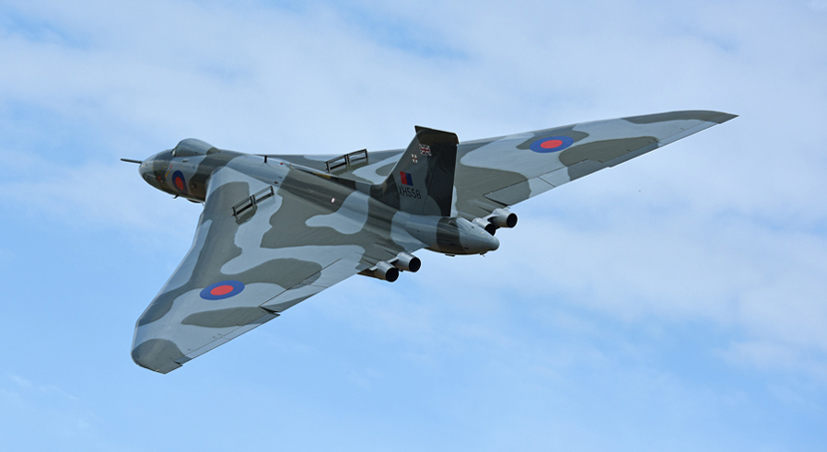
Unfortunately, the inevitable cost saving considerations soon saw the disbandment of the Vulcan Display Flight and on 20th September 1992, XH558 performed her final display as an RAF aircraft at Cranfield and headed for something of an uncertain future. The first Vulcan B.2 to enter RAF service, XH558 would also have the honour of being the last of the Royal Air Force Vulcans. Put up for disposal, the aircraft was purchased by a private buyer and flown to the former RAF airfield at Bruntingthorpe on 23rd March 1993, where she would be maintained in ground running condition, the future star attraction of the ‘Cold War Jets - Rolling Thunder’ fast taxi run events held at the airfield. Despite being well cared for and housed in an impressive hangar, the future of this majestic aircraft continued to remain uncertain, even though fascinating rumours began to circulate about ambitious plans to return the aircraft to the skies once more.
As the most popular attraction at Bruntingthorpe events, the new owners of Vulcan XH558 were in no doubt as to the affection in which their new aircraft was held, but returning a former RAF V-force bomber to the skies in civilian hands was surely nothing more than an aviation pipe dream. If they were to succeed, they would have to negotiate the most complex return to flight project ever attempted in the world and with a multitude of potential pitfalls ahead of them, the ambitious ‘Vulcan to the sky’ project was surely destined for failure – while the aviation world looked on with interest, most people doubted they could pull this off.
Over the course of the next few years, this hugely challenging undertaking continued apace, with the complexity and eye watering costs associated with the project ensuring that the name Avro Vulcan was always associated with the need for more money. Miraculously, thanks to the determination and professionalism of the restoration team and the generosity of thousands of individuals and business owners, they did it - they returned a Vulcan bomber to airworthy condition and received clearance to begin test flying.
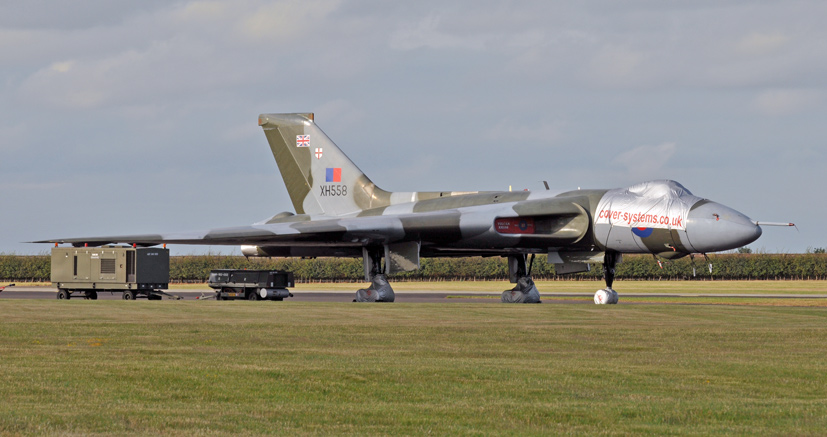
It is fitting that the first post restoration Airshow appointment for Vulcan XH558 was RAF Waddington, an airfield which played host to so many Vulcan’s during their service career
Even as XH558 powered up her engines and sped off down the runway at Bruntingthorpe on 18th October 2007, millions of astounded onlookers could hardly believe what they were seeing. Overcoming seemingly insurmountable odds, the only flying Vulcan immediately became the most famous historic aircraft in the world and with it, the most complex aircraft on the British civilian register. Successfully completing her first post restoration flight, it would not be until the following July that she would make her public display debut, which rather fittingly took place at the RAF Waddington Airshow, an airfield which was formerly the home of so many Vulcans. That first display marked the beginning of Britain’s love affair with an aviation relic of the Cold War and one of the most distinctive aircraft ever to take to the skies.
As arguably the most popular aircraft to have ever graced the display programme of a British Airshow, XH558 proved to be a huge crowd puller over the next few years, guaranteeing large attendance numbers at any event where she was scheduled to appear. Given the unofficial title ‘The Spirit of Great Britain’, the Vulcan commanded a level of enthusiast support that other aircraft could only dream of and when requests for additional funding were made, these funds were always made available, either from donations made by a Vulcan adoring public, or wealthy benefactors who had a similar XH558 infatuation. Creating an aviation phenomenon known as the ‘Vulcan Effect’, any event which promised the appearance of the Vulcan could count on huge crowds, both inside the event and gathered in the surrounding area – this mighty delta was a real crowd pleaser.
Unfortunately, even this much loved aeroplane which seemed to defy the odds at every turn could not fly on forever and news that essential technical support provided by expert aviation companies would not be continued past the 2015 Airshow season meant that Britain was thankfully allowed some time to get used to the fact that our Vulcan just had one Airshow season left, before being grounded for good. This advanced notification resulted in the aircraft being in even more demand than usual, as every show it was booked to attend would be the last time it would display there and enthusiasts were desperate to be amongst the crowd for this sad occasion and grab their all-important and rather historic pictures.
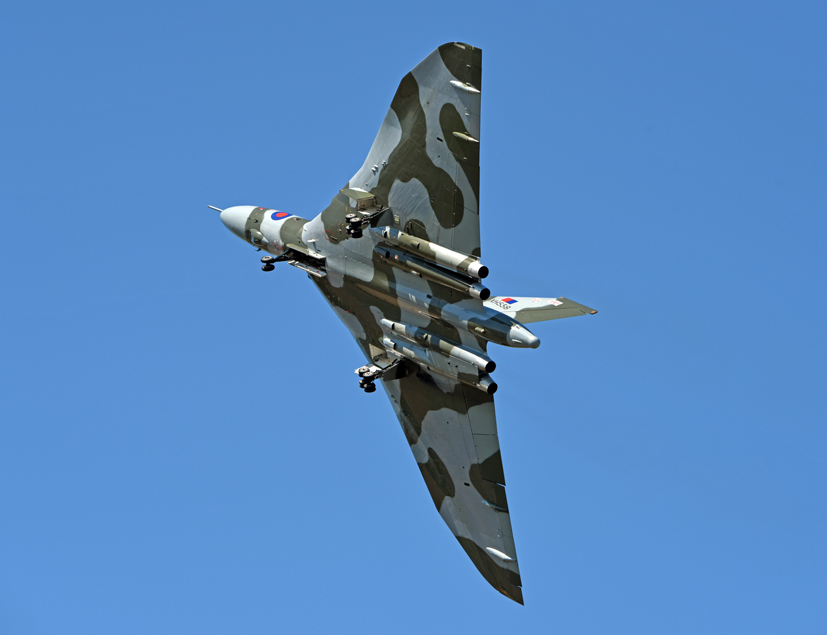
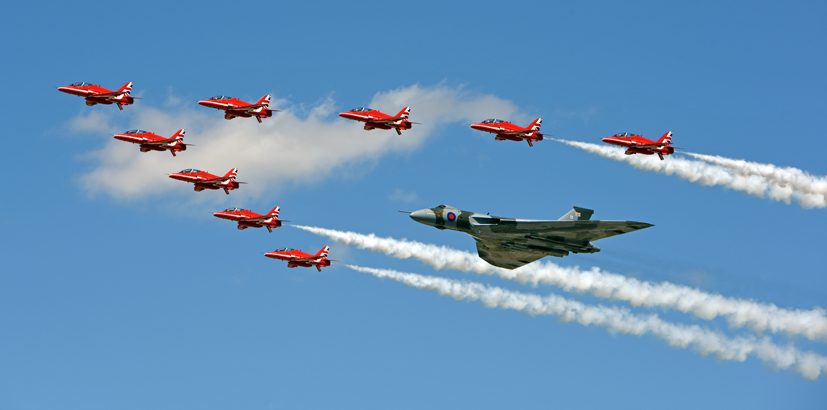
Perhaps the highlight of this final display season was her appearance at the massive Royal International Air Tattoo and a chance for the largest crowds of the Airshow year to say their goodbyes. Beautiful weather ensured this sad occasion proved to be a memorable one and in true Vulcan style, the flight crew were in no mood for letting their unique aircraft pass into the aviation history books in a sedate and graceful manner - those fortunate enough to be in attendance during the Sunday display will have been delighted to have witnessed a particularly spirited take off and confirmation of why we all loved the Vulcan so much.
As the final RIAT appearance of the Vulcan was clearly going to be a significant landmark in the history of British aviation, the occasion was crying out to be marked in some style and in situations like this, who better to call upon than the services of the Royal Air Force Aerobatic Team, the Red Arrows. On both days of the show, Avro Vulcan B.2 XH558 became the tenth member of this famous team, as they performed an impeccable formation flypast under glorious blue skies for the gathered masses and with it, producing the defining aviation moment of RIAT 2015.
In a development which saw unprecedented crowd numbers attempting to catch one final glimpse of XH558 in the air, the Vulcan to the sky team arranged an ambitious ‘National Tour’ for the aircraft, which took place over the weekend of 10th/11th October 2015, allowing as many people as possible to say goodbye to this much loved Cold War bomber and icon of the British aviation industry. With a list of waypoints published in advance, there was definitely only one place where I wanted to pay my own personal Vulcan respects, the former Avro airfield at Woodford and birthplace of Avro Vulcan B.2 XH558 – a most appropriate location.

A sight millions of people were hoping to see during the final ‘National Tour’ of the Vulcan
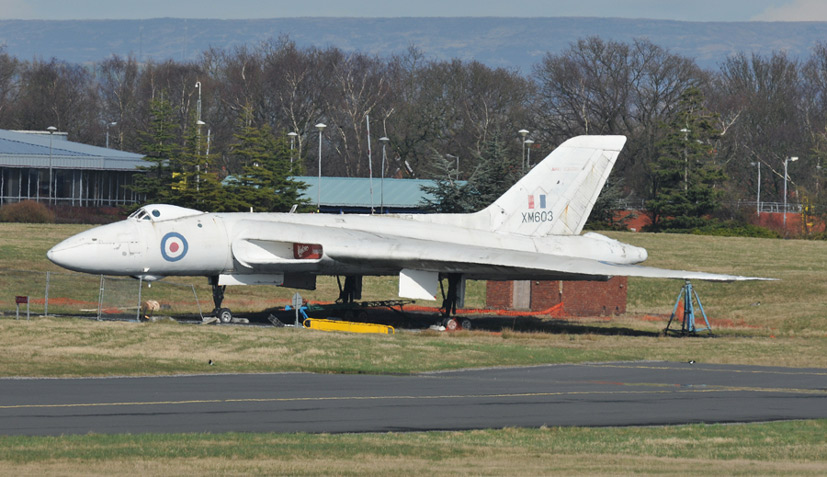
Long time Woodford resident XM603 looking rather sorry for itself in the years immediately prior to the demolition of the historic Avro factory and birthplace of the Vulcan
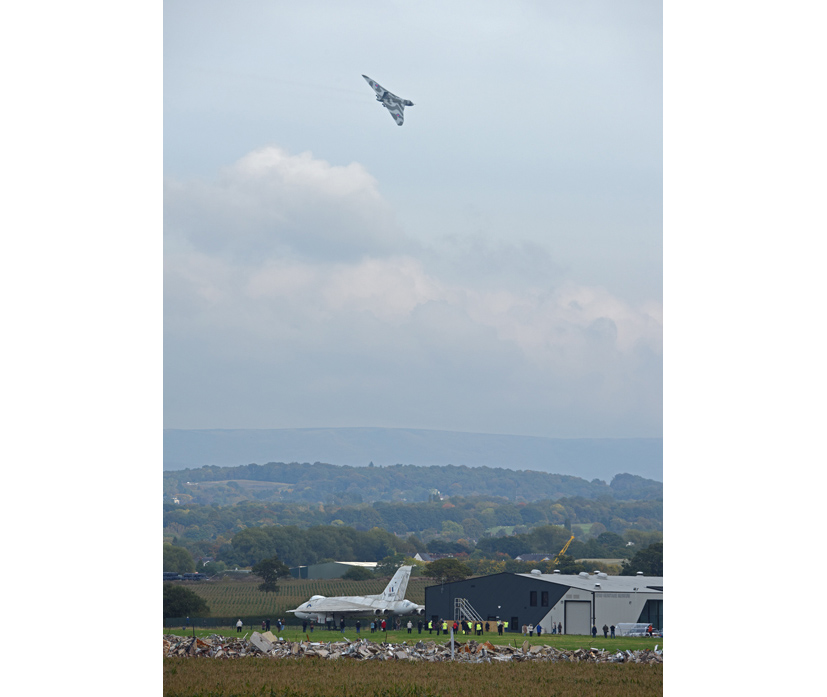
Shot of the day, Avro Vulcan XH558 turns above XM603 and the Avro Heritage Centre, as it flies over the place of its birth for the final time
With this historic site now demolished and subject to a major housing development, the event centred around the new Avro Heritage Museum, even though at that time it was closed to people attending this ticket only event. Tracking the route of the Vulcan all the way, its single pass down the length of Manchester Airport’s main runway meant that we were next and everyone prepared to experience a little piece of aviation history. Performing two memorable passes over the site, which included the aircraft banking over its former squadron-mate and long time Woodford resident Avro Vulcan B.2 XM603, which allowed for some memorable photographic opportunities, that was it. As she headed off for her next flypast waypoint, a rather sombre crowd began to disperse and whist XH558 would make one final flight later that same month, this proved to be my last sight of a Vulcan in the air. The reign of the Vulcan was finally over and the UK Airshow scene would never be the same again.
It has now been four years since the Vulcan last graced Britain’s skies, but as the aircraft had something of a reputation as an aviation phoenix rising from the ashes of improbability, I’ll bet that I was not the only one hoping that this was not the end of the Vulcan story. Sadly, that hope now seems to be dashed and for an aircraft which was once admired by many millions of people, she is now virtually inaccessible to most of us, with her future looking more uncertain than ever. Thankfully, we all have our memories and can proudly admit to have been afflicted with a virulent dose of 'Vulcanitis'.

The consummate Airshow performer, will an aircraft ever rival the popular appeal of the Vulcan in the hearts of the UK public?
I am afraid that is all we have for you in this latest edition of Aerodrome, but we will be back as usual in two weeks’ time with more aviation related content for your enjoyment. If you would like to send us a selection of your own pictures, or suggest an aviation related subject you would like to see covered in a future edition, please use our aerodrome@airfix.com address, where we will be delighted to hear from you.
In between new editions of our blog, the aviation related conversation continues over on the Airfix Aerodrome Forum and we can also be contacted on either the Airfix or Corgi Facebook pages, in addition to Twitter for both Airfix and Corgi - please do get involved in the discussions and let us know what you think about Aerodrome.
The next edition of Aerodrome is due to be published on Friday 29th November, where we look forward to bringing you even more interesting aviation related features.
Thank you so much for continuing to support our Aerodrome blog.
Michael
Return to the Aerodrome Home Page
© Hornby Hobbies Ltd. All rights reserved.